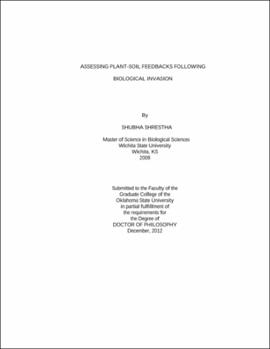| dc.contributor.advisor | Hickman, Karen R. | |
| dc.contributor.author | Shrestha, Shubha | |
| dc.date.accessioned | 2013-11-26T08:26:10Z | |
| dc.date.available | 2013-11-26T08:26:10Z | |
| dc.date.issued | 2012-12 | |
| dc.identifier.uri | https://hdl.handle.net/11244/6849 | |
| dc.description.abstract | Alteration in ecosystem processes following biological invasion is likely to occur if the invasive plant species exhibit different physical and physiological traits than those of the native species. The alteration of soil chemical properties has enormous potential for the modification of other plant species and microbial communities. Therefore, understanding plant-soil feedbacks by biological invasion may be a critical aspect of the restoration of native ecosystems. Two non-native plant species, Tamarix sp. (saltcedar) and Lespedeza cuneata (sericea lespedeza) were selected for the study. I conducted separate field and greenhouse studies to assess potential plant-soil feedbacks for each species. In field study, soil samples were collected 1) beneath non-native plants in highly invaded areas; 2) from areas where non-native plants have been removed (restoration areas); and 3) from adjacent native prairie. Soil was processed for abiotic (pH, N, P, K) and biotic (microbial communities) properties. My greenhouse study assessed plant-soil feedbacks indirectly through biomass production of different native and non-native plant species grown in soil collected from the same three sites as field study. Plants were grown for 16 weeks, at which time biomass production was determined. Percent root colonization by arbuscular mycorrhizal (AM) fungi was determined microscopically. Greater soil salinity, pH, nitrate-nitrogen, potassium, and phosphorus and greater soil microbial communities from Tamarix invaded sites were observed relative to native prairie sites. Greater nitrate-nitrogen and phosphorus were observed in soil from L. cuneata invaded sites compared to soil from native areas. The legacy of invasion persisted five years and a year after removal of Tamarix and L. cuneata respectively with similar trend in soil abiotic and biotic properties as in invaded sites. Both native and non-native plant species produced greater biomass in soils collected with a history of biological invasion, as compared to production in soil from native sites. Different plant species showed different percentage of AM fungal root colonization when grown in soil with a history of biological invasion compared to soil from native areas. | |
| dc.format | application/pdf | |
| dc.language | en_US | |
| dc.rights | Copyright is held by the author who has granted the Oklahoma State University Library the non-exclusive right to share this material in its institutional repository. Contact Digital Library Services at lib-dls@okstate.edu or 405-744-9161 for the permission policy on the use, reproduction or distribution of this material. | |
| dc.title | Assessing plant-soil feedbacks following biological invasion | |
| dc.contributor.committeeMember | Wilson, Gail W. T. | |
| dc.contributor.committeeMember | Owens, Michael Keith | |
| dc.contributor.committeeMember | Steets, Janette Ann | |
| osu.filename | Shrestha_okstate_0664D_12538.pdf | |
| osu.accesstype | Open Access | |
| dc.type.genre | Dissertation | |
| dc.type.material | Text | |
| dc.subject.keywords | invasive | |
| dc.subject.keywords | mycorrhizae | |
| dc.subject.keywords | plant-soil feedbacks | |
| dc.subject.keywords | plfa | |
| thesis.degree.discipline | Natural Resource Ecology and Management | |
| thesis.degree.grantor | Oklahoma State University | |
